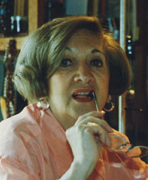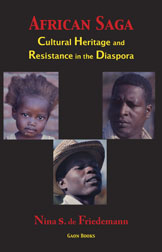Nina S. de Friedemann
Author

Nina S. de Friedemann was born in Bogotá, Colombia and studied at the Colombian Institute of Anthropology, Hunter College, and the University of California in Los Angeles. She taught at the National University of Colombia and as a visiting professor at Georgia State University and the University of Alabama. For more than 30 years she conducted extensive research projects on Afro-Colombia groups and ethnic relations along the Caribbean coast, in the Valle de Cauca, and in various parts of the Choco.
She wrote 18 books, including African Saga: Cultural Heritage and Resistance in the Diaspora (Gaon Books), From Sunrise to Sunset (with Jaime Arocha, Planeta, 1986), Black Councils: Africanity Shelters in Colombia (Montalbán, Caracas, 1988), Kinship Trunks Among Black Miners in Colombia National University of Colombia, Carnival in Barranquilla (La Rosa, 1985); Language and Society in the Palenque de San Basilio, in collaboration with Carlos Patiño (Caro y Cuervo Institute, 1983); Ma Ngombe: Warriors and Farmers in Palenque, in collaboration with Richard Cross (Carlos Valencia Publishers, 1979). Heirs of the Jaguar and the Anaconda, in collaboration with Jaime Arocha. She also directed anthropological films with Ron Duncan Hart and Gloria Abella Ballen. She was a founding member of the Anthropological Society of Colombia and the National Union of Writers, a Research Associate in Social Change at Emory University and a member of the American Anthropological Association and the Society for the Anthropology of Visual Communication. She received a Fulbright-Hays Senior Scholar Award, as a visiting professor in the United States. In 1987 she was nominated by the National Union of Writers of Colombia for the Gabriela Mistral Inter-American Award for writing, established by the Organization of American States.
African Saga: Cultural Heritage and Resistance in the Diaspora
Nina S. de Friedemann
Prologue
Without the profound and delightful writings of the anthropologist, Nina S. de Friedemann, we would know very little about our Black communities of the Pacific Coast [of Colombia], and we would not know the majority of their cultural contributions. We would know almost nothing of their patterns of behavior, thought, and living. More than anything else, we would love them less. The humid and abandoned rain forests of Pacific Coast of Colombia shelter a large, basically unassimilated Afro-American population. This isolation has permitted it to preserve its spiritual heritage with jealous pride and admirable tenacity up to the present day.
To that Coast the slaves arrived primarily as gold miners along the many streams of the region especially after 1700. Afterwards they, and their free descendents after 1851, worked in the small scale and industrial sugar mills or on the cattle ranches of the Cauca Valley. Almost all arrived through Cartagena and came up the Magdalena River to arrive to the Chocó and the Coasts of the Departments of Valle, Cauca and Nariño. A smaller number went up the Atrato River from Cartagena, and the remainder was sent to Jamaica or Panamá where they were taken to the bays and estuaries of the Pacific Coast, almost always fraudulently.
The large majority of this Black population entered the country in the 18th century, starting in 1700 when gold mining experience an unusual surge in the Chocó and other places along the Pacific Coast. During that period there was a plentiful supply of Bantu slaves who arrived in a massive wave, especially along the Atlantic Coast. In the period between 1580 and 1640 (the unification of the crowns of Spain and Portugal) that supply decreased and was replaced in the second half of the 17th century by people from the Ewe, Fon, and Akan tribes. These latter tribes continued to dominate the 18th century when they shared their dominance with the Bantus (Efik and Igbo) while they still dominated them, but without making them lose their cultural importance.
As Robert C. West points out in his excellent, classic monograph The Pacific Lowlands of Colombia, the Cape of Currents divides our Pacific Coast like a powerful marker. To the north are the cliffs of the Baudo Mountains (and the Sapo Mountains in Panama) interspersed with beautiful beaches of fine sand and interrupted by promontories jutting into the sea called longos. To the south the manglars border the coasts of central Chocó, the Valley of Cauca, Cauca, and Nariño, and they extend into Ecuador beyond Esmeraldas. Between the manglar and the sea there are also beaches. The manglar has been described in its incredible beauty by Professor Von Prahl. Although manglar trees seem to be of one single botanical family, they are constitute four or five that have adapted their leaves, branches, and roots to the saltwater environment in which they flourish. One of these manglar families is a cousin of the camelia that grows in the highlands of Bogotá, and since we learned about this, it does seem that the leaves of the camelia do have a strange similarity to the leaves of the manglar.
In the Chocó, the water from the strong rains drains primarily into two great river systems: the Atrato River that flows to the Atlantic and the San Juan River that flows to the Pacific. In contrast, to the south of Buenaventura medium sized rivers dominate with the exception of the Patia. Between the Atrato and a tributary of the San Juan there is a short stretch of land that today is connected by bus. In the Colonial Period goods people crossed this distance by the "arrastradero de San Pablo", which refers to Indian laborers pushing the canoes loaded with trade goods to be transferred to other canoes, and in this way they passed from one river basin to the other. To the south of Buenaventura people sailed in the open sea or through long canals of seawater parallel to the coast, escorted by the immense jungles of manglar.
So, it should not be strange to us that it took four years to completely explore the Pacific Coasts of Colombia and Ecuador whereas the Atlantic Coast of Colombia required only four months. To crown this huge achievement, Pizarro and Almagro agreed to divide the work between them. Almagro took the task of returning to Panama to recruit more people to replace those who died and to get more food for the living. In the meantime Pizarro waited in some inhospitable place of the Pacific Coast, such as the coast of Chocó, the mouth of the San Juan de Micay River, the island of Gallo, or the island of Gorgona to await the indispensable help. It was not possible to found a town, neither along the coast or on the islands, to act as a supply center and a base for further explorations to the south. Between Panama and Peru there was no place that an expedition could equip or supply itself. Nothing similar happened anywhere else in the Americas, neither Hernando de Soto's trip into the United States, no the hard trip of Quesada from Santa Mart to Bogotá. None of them lasted four years.
With the exception of Nabugá, Bahía Solano, Tribugá, Nuquí, Buenaventura, Timbiquí, Guapi and Tumaco, Nina de Friedemann has worked mostly with populations to the interior from the coasts and even in intermontance valley communities, such as Quibdó, Istamina, Tadó, Yuto, Lloró, Bagadó, Chambaré, Muchichí, Cuajandó, Engrivadó, Cértegui, Tutunendó, Neguá, Beté y Tagachí in the Department of Chocó, Bajo Calima and Jamundí in the Department of Valle del Cauca; Coteje, Santa María, Mechengue, Vallarica, Miranda, Corinto, Coloto y Puerto Tejada en the Department of Cauca; Barbacoas, Zapote, Los Brazos, El Venero, Gertrudis in the Department of Nariño. In a very general way, these are the places where Black miners were active during the early years of the Republic. After the slaves were liberated in 1851 up to 1920 Black people had to move to the Pacific coast to find employment.
It is difficult for me to imagine Nina de Friedemann, a small woman who is sweet and feminine, traveling through those humid jungles, sleeping in hammocks or on the ground, and moving from place to place in canoes or dug-outs through the formidable system of rivers and tributaries, which is the only means of travel in most of the Pacific Littoral. Nina has crisscrossed most of these rivers: Anchicayá, Napi, Mechengue, Bubuey, Saija, Timbiquí, Guapi, Satinga, Sanquianga, Güelmambí, Telembí, Ispí, Yaguapí, Patía, Maguí, Nansalbí, and Sumbiambí. She has also covered the Atrato and its tributaries: Comingodó, Opogodó, Napipí, Bojayá, Buchadó, Tagachí, Bebará, Beté, Neguá, Munguidó, Quito, Tanadó, Capá, Yuto, Andágueda and Cértegui.
But, Nina has not limited her activities to the Pacfic Littoral. She has also done studies in San Andrés and Providencia, San Basilio de Palenque, Cartagena, Barranquilla, and many other sites along the Atlantic Coast. Several articles have resulted from these trips and her many lectures on the Black speakers of creole and English in San Andrés and Providencia, on the cattlemen of Palenque and the funerary rites (lumbalú) from the same place. She also has written about the Slave Councils in Cartagena and that Carnaval in Barranquilla, whose dance groups have so much projection.
All of these subjects and more are covered in this book, which is a prodigious synthesis of the African experience in Colombia. It includes much of what has been written about Blacks in Colombia and the most recent publications by Black authors in the country about their continent.
This book confirms the facility with which Nina de Friedemann weaves together the experience of Blacks in the gold mines of the Pacific Coast, their social organization (cuadrillas and troncos), their work methods, daily life, desires, and needs. She covers many other subjects such as the African cultural contributions to Colombia in the music, art, and institutions.
This book will become a must read for students of anthropology and sociology and a necessary reference for professors and scholars of these subjects.
Nicolas del Castillo Mathieu
Gaon Books
P.O. Box 23924
Santa Fe, NM 87502
505.920.7771
gaonbooks@gmail.com
Gaon Books
Excellence in Publishing
All images and texts in this website are under copyright.
To use materials please contact Gaon Books

